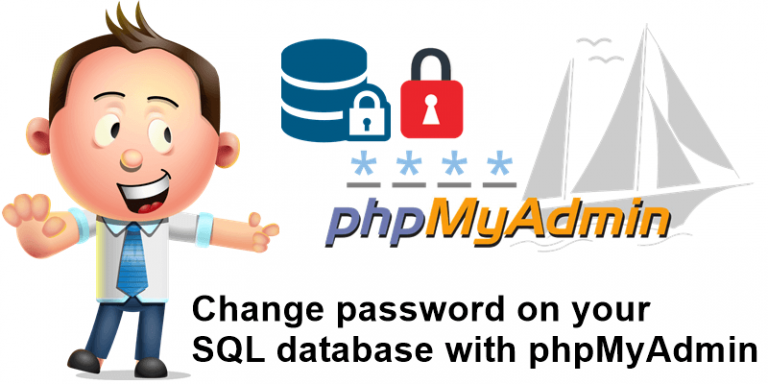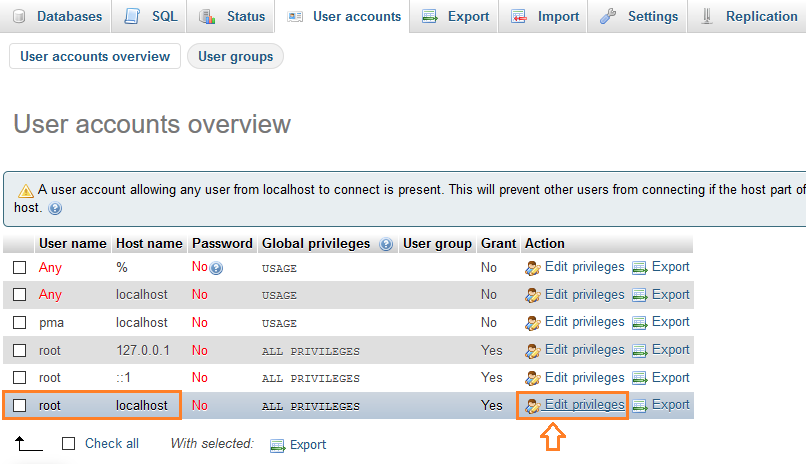
Network Security, WiFi Security, WiFi Hackers, Firewalls, Wireshark, Secure Networking.
#CHANGE PASSWORD PHPMYADMIN HOW TO#
In this first example, we’ll see how to insert a new line directly from PHP.Ĭomplete Security Course Become a cyber security specialist. In PHP, there is a pack of functions, starting by mysqli_* that allow you to work with MySQL database.

I’ll show you with PHP as it’s the most used language for MySQL, but you can find similar functions in other languages too. You now know almost everything, the only step missing is how to check the used password is correct on sign in. But for my basic table, it’s enough 🙂 PHP You can find the MySQL documentation here if you have any specific thing to handle. In the Change password section, you’ll need to enter your new password and then click the Go button. Once you’re in phpMyAdmin, you’ll need to select the Users tab and then click on the Edit icon next to the root user. Once you have the MySQL Query set for your new users, you can click on “SQL” and paste it directly in PHPMyAdmin. First, you’ll need to log into your GoDaddy account and navigate to the phpMyAdmin tool. This query will do the same thing for example: INSERT INTO users So, we just add the “MD5()” function to the password in text, and it will insert a line with a MD5 hash.īy the way, the auto_id field is not mandatory, and will be filled automatically even if you don’t set it to “NULL” in the query. In any case, here is an example: INSERT INTO users If you followed the previous method with PHPMyAdmin, you may have seen the MySQL query displayed on your screen. This should be more convenient than PHPMyAdmin to do this automatically. In this part, I’ll show you how to do the same thing directly in MySQL, but also with PHP. Once done, the lines look like this: The password is correctly encrypted in the field Set a MD5 Password in MySQL and/or PHP directly For more common frameworks like WordPress, your database should start with wp followed by a group of numbers. Step Two Look for the database that corresponds with the site you want to gain access to. Stay tuned with the latest security news! You'll enjoy receiving the recent articles directly in your inbox every week! I'm in! Step One Find the PHPMyAdmin option in your cPanel, or which ever hosting panel you have. You can now submit the form, and insert another line if you want.Your form should look like this: Not so complicated hum? 🙂.Before submitting the form, you need to encrypt the password in MD5 To do this, find the “MD5” function in the dropdown list.Enter the “password” in clear mode in the value column.The “auto_id” needs to stay empty (will be automatically set).A form shows up with all the fields from your MySQL table.Browse to the “users” table (or whatever the name of your table is).Here is how to set a MD5 password while inserting your values in PHPMyAdmin:

In this part, I’ll show you how to do this, but if you are also interested in the MySQL query, I’ll give it to you just after. In PHPMyAdmin, you can insert new lines with a form, you don’t need to type the MySQL query each time. We are now ready to insert a new line in this table! Insert a new line with PHPMyAdmin
#CHANGE PASSWORD PHPMYADMIN FOR FREE#
Open it with your text editor, I use Note++, add your new password between the brackets ex.Hide your IP address and location with a free VPN: Try it for free now, companies are paying for you.ġ500 servers in 120 countries. You will see a random password generated that you are welcome to use.

To the right of it, you will see a button labeled Generate Password. When you see your Admin profile, scroll down until you find the option labeled New Password. The wp-config file is located under your Web folder>Name of your site>wp-config. Hover over your Admin user and then click on Edit.


 0 kommentar(er)
0 kommentar(er)
